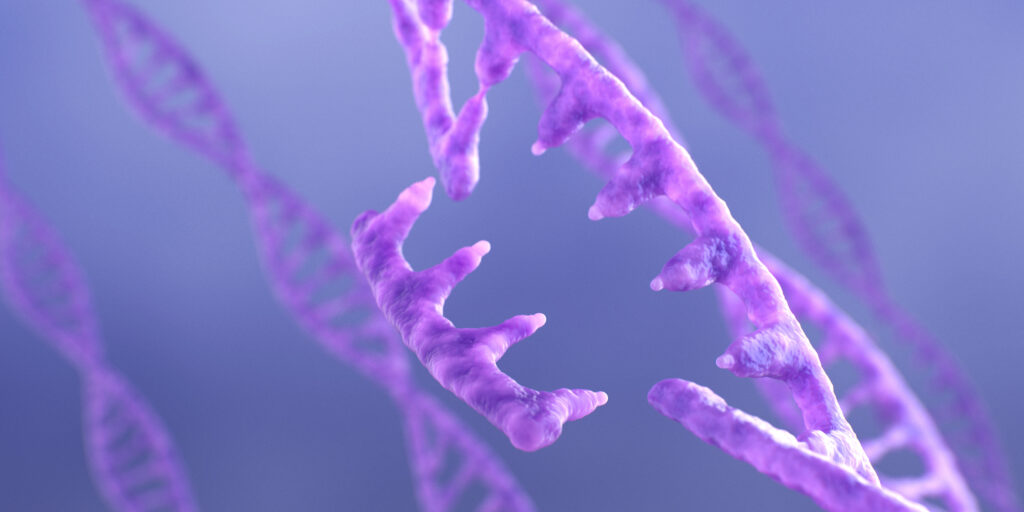
Simply Stated: Updates in Exon Skipping Technology
By Sujatha Gurunathan | Wednesday, July 31, 2024
5 Second Summary
“Simply Stated” is a Quest column designed to explain some terms and basic facts about neuromuscular diseases.
Find more at Mdaquest.org/tag/simply-stated
Over the last decade, there has been a boom in the development of exon skipping therapies to treat people living with the rare neuromuscular disease Duchenne muscular dystrophy (DMD). Treatment with exon skipping therapies makes the effects of DMD less severe for some people with the disease, and new generation therapies on the horizon provide hope for increased efficacy and improved disease management for people with DMD.
What is DMD?
DMD affects approximately 1 in every 3,500-5,000 male births worldwide and leads to severe progressive muscle loss and premature death in affected individuals. It is caused by a mutation in the dystrophin gene on the X chromosome that results in little or no production of dystrophin protein. The dystrophin gene is made up of 79 sections, known as exons, that provide instructions for making the dystrophin protein. A mutation in one of these sections can cause the exons to fit together improperly, thereby distorting the gene’s instructions and preventing the cell from making functional dystrophin protein.
How exon skipping works
Exon skipping technologies use small fragments of genetic material called antisense oligonucleotides (ASOs) to bind to the dystrophin gene and trick the gene expression machinery to skip over specific exons when the gene’s instructions are being copied. The instructions in the dystrophin gene are copied into an RNA message, and this message is read by the cell’s protein-making machinery to make dystrophin protein. Exon skipping allows deletion of mutation-containing exons in the RNA message, enabling the cell to bypass some dystrophin mutations and make a shortened dystrophin protein. This shortened protein is expected to act similarly to normal dystrophin, and alleviate some of the symptoms of DMD.
Exon skipping technology was pioneered by Dr. Steve Wilton, a primary investigator at the University of Western Australia in Perth. In 1996, MDA provided Dr. Wilton with a starter grant to develop this groundbreaking technology, helping to lay the foundation for the exon skipping therapies available today. To learn about the early development of exon skipping therapies, visit the Quest blog post Once a Wild Idea, Successful First-Generation Exon-Skipping Therapies Pave the Way for Personalized Treatments.
FDA approved first-generation therapies
Development of exon skipping therapies have transformed the neuromuscular disease treatment landscape. In September 2016, eteplirsen (marketed by Sarepta as Exondys 51) became the first exon-skipping therapy approved by the US Food and Drug Administration (FDA) to treat DMD. Exondys 51 is useful in approximately 13% of people with DMD whose dystrophin production can be restored by skipping exon 51. Approval in December 2019 of golodirsen (marketed by Sarepta as Vyondys 53) and in August 2020 of viltolarsen (marketed by NS Pharma as Viltepso) was another step forward in the development of exon-skipping therapies for DMD. These drugs were designed to treat the approximately 8% of patients with DMD amenable to skipping exon 53. Casimersen (marketed by Sarepta as Amondys 45), approved in February 2021, is the most recent exon skipping therapy to reach the market. Amondys 45 is designed to treat the 8% of people with DMD who have mutations amenable to skipping of exon 45. Together, the currently available exon-skipping therapies benefit about 30% of people with DMD.
It is important to highlight that all of the available exon skipping therapies were conditionally approved by the FDA and that phase 3 studies for full approval are still underway. A long-term study of eteplirsen treatment of people with DMD for up to 8 years has demonstrated positive results, suggesting that treatment may prolong survival. A confirmatory study (RACER53) of NS Pharma’s Viltepso, on the other hand, recently failed to meet its primary endpoint. The company is conducting a more detailed analysis of the trial to identify factors that could have influenced the outcome, and is working with regulatory authorities to determine next steps for the therapy. Viltepso continues to be available for use in the meantime.
The available therapies represent first-generation exon skipping technology, and some individuals seem to respond better to these therapies than others. The reasons why some exon skipping therapies may perform differently in the body are still being studied. Differences in efficacy may result from the type or number of mutations that some individuals with DMD have, or perhaps be related to length or dose of the therapy that is given.
Importantly, the first-generation exon skipping therapies are made from a type of ASO known as a phosphorodiamidate morpholino oligomer (PMO). PMOs are chemically modified to have a backbone that has a neutral electric charge. This makes it easy to add proteins or peptides to the therapy to help it reach and penetrate muscle cells more effectively, a fact which researchers are currently leveraging to design better therapeutics.
New exon skipping therapies on the horizon
Multiple groups have exon-skipping therapies at various stages in the drug development pipeline. Some are using existing PMO technology, but providing new therapeutic options or targeting different subsets of people with DMD (e.g. those with DMD amenable to exon 44 or exon 50 skipping). Others are using modifications to overcome challenges of first-generation therapies. A known barrier to the effectiveness of current therapies is the ability to deliver the drugs to all of the needed areas in the body, such as the heart. Some researchers are working to modify the sequence, chemistry, and backbone stereochemistry of PMO-based therapeutics to try to improve delivery into muscles. Another approach involves the use of peptide- or antibody-based-delivery tags that enable the PMOs to get into specific cell types in the body. The goal is to better target the drugs so that they are more effective in boosting dystrophin levels in the muscle cells that need it. Exon skipping therapies in clinical development include the following:
Expanded options for specific DMD populations
NS-089/NCNP-02 (NS Pharma) is an exon skipping therapy for people with DMD amenable to exon 44 skipping. This therapy is being studied in a phase 2 trial that is actively recruiting participants.
NS-050/NCNP-03 (NS Pharma) is an exon skipping therapy for people with DMD amenable to exon 50 skipping. This therapy is being studied in a phase 1/2 trial that is not yet recruiting participants.
BMN 351 (Biomarin) is an exon skipping therapy for people with DMD amenable to exon 51 skipping.
This therapy is being studied in a phase 1/2 trial that is actively recruiting participants in several European countries.
Therapies designed to better penetrate cells
SRP-5051 (Sarepta) is a next generation version of eteplirsen. Similar to eteplirsen, SRP-5051 is designed to skip exon 51, however, it is bound to a peptide that can help the therapy enter cells in the body. In January 2024, Sarepta announced positive data from its phase 2 MOMENTUM study stating that trial participants treated with SRP-5051 showed significantly higher increases in dystrophin protein and exon skipping compared to those treated with eteplirsen.
ENTR-601-44 (Entrada Therapeutics) is an exon skipping therapy that uses a special Endosomal Escape Vehicle (EEV) technology to increase uptake of the therapy by the cell. ENTR-601-44 is for people with DMD amenable to exon 44 skipping. In June 2024, Entrada announced that administration of ENTR-601-44 to healthy volunteers in a phase 1 clinical trial demonstrated significant plasma and muscle concentration of the drug, as well as exon skipping. Based on these proof-of-concept findings, the company is planning regulatory filings and initiation of a phase 2 clinical trial later in the year.
Therapies designed to specifically reach muscle cells
PGN-EDO51 (PepGen) is an exon skipping therapy that is bound to a peptide that targets muscle cells. PGN-EDO51 is for people with DMD amenable to exon 51 skipping. In January 2024, PepGen announced that it had dosed the first participant with PGN-EDO51 in the phase 2 CONNECT1-EDO51 clinical trial, which is actively recruiting participants in Canada.
WVE-N531 (Wave Life Sciences) is an exon skipping therapy that has specific modifications to its backbone (PN backbone chemistry modifications) to help the therapy reach muscle cells. WVE-N531 is for people with DMD amenable to exon 53 skipping. In December 2023, Wave announced initial dosing of participants with WVE-N531 in the phase 2 FORWARD-53 clinical trial, which is ongoing in Canada and the United Kingdom (UK).
AOC 1044 (Avidity Biosciences) is an exon skipping therapy that is bound to a monoclonal antibody (mAb) that targets the muscle cells. AOC 1044 is for people with DMD amenable to exon 44 skipping. In December 2023, Avidity announced that administration of AOC 1044 to healthy volunteers in the phase 1/2 EXPLORE44 trial resulted in delivery of 50 times more of the therapy to muscle tissue than administration of the same therapy bound to a targeting peptide.
Dyne-251 (Dyne Therapeutics) is an exon skipping therapy that is bound to an antibody portion, known as the antigen-binding fragment (Fab), which targets muscle cells. Dyne-251 is for people with DMD amenable to exon 51 skipping. In May 2024, Dyne announced new clinical data from its 1/2 DELIVER trial in people with DMD and its phase 1/2 ACHIEVE trial in people with another neuromuscular disease, myotonic dystrophy type 1 (DM1). In both trials, treatment with Dyne-251 demonstrated meaningful impacts on key biomarkers and functional improvements in affected participants.
Exon skipping gene therapy
scAAV9.U7.ACCA (Nationwide Children’s Hospital) is an exon skipping gene therapy for people with DMD that have a duplication of exon 2 in the DMD gene. This therapy uses a viral (AAV) delivery system to bring a new therapeutic gene into the cell. The introduced gene encodes an RNA sequence that can bind near exon 2 in the DMD gene and mask exon 2 duplications while the dystrophin gene is being read, copied, and translated into protein. The therapy is expected to produce normal, full-length dystrophin protein, and as a gene therapy, is designed to sustain this production over time. scAAV9.U7.ACCA is being studied in a phase 1/2 trial that is active, but not currently recruiting participants.
In addition to the abovementioned clinical trials, preclinical studies of exon skipping methodologies are also underway. For example, use of CRISPR-Cas9 gene editing to skip defective exons in the dystrophin gene is being tested in cell and animal models of DMD. These and other research advances provide hope for improved disease management for people living with DMD. Improving the efficacy of exon skipping therapies and expanding their use to other subsets of people with DMD (and to other diseases like DM1) will take time, however. To learn more about clinical study opportunities using exon skipping technologies, visit clinicaltrials.gov and search for “exon skipping” in the Intervention/treatment field.
MDA’s Resource Center provides support, guidance, and resources for patients and families, including information about exon skipping therapies, open clinical trials, and other services. Contact the MDA Resource Center at 1-833-ASK-MDA1 or [email protected].
Next Steps and Useful Resources
- To learn about the early development of exon skipping therapies, visit the Quest blog post Once a Wild Idea, Successful First-Generation Exon-Skipping Therapies Pave the Way for Personalized Treatments.
- For more information about the Duchenne Muscular Dystrophy (DMD), an in-depth review can be found here.
- NS-089/NCNP-02 (NS Pharma) is an exon skipping therapy for people with DMD amenable to exon 44 skipping. This therapy is being studied in a phase 2 trial that is actively recruiting participants.
- MDA’s Resource Center provides support, guidance, and resources for patients and families, including information about exon skipping therapies, open clinical trials, and other services. Contact the MDA Resource Center at 1-833-ASK-MDA1 or [email protected].
- Stay up-to-date on Quest content! Subscribe to Quest Magazine and Newsletter.
Disclaimer: No content on this site should ever be used as a substitute for direct medical advice from your doctor or other qualified clinician.




